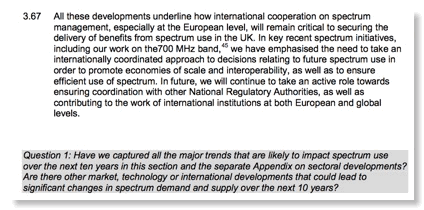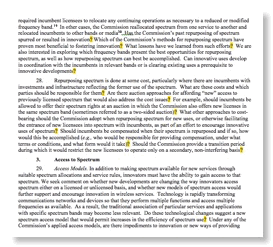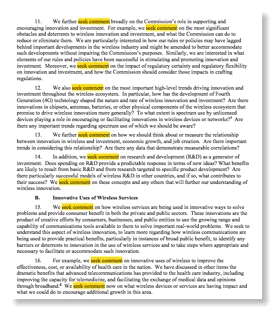Do FCC NOIs/NPRMs Have Too Many Poorly Organized Questions?
A Comparison with Ofcom and IC
FCC NOIs and NPRMs tend to have lots of questions, generally very poorly organized questions. Why? It is the byproduct of the coordination between the various bureaus and offices within the FCC staff and then with the 5 commissioners. It is very easy for all of the above to raise concerns. The authors seek to by them off by adding another question, hence questions keep growing and growing. Since no one is really in charge, there is no accountability for adding a question and it is often the price of getting a concurrence that is needed to meet a deadline.
Questions with “seek comment” in Docket 09-157 NOI
Let’s consider the “Wireless Innovation NOI, Docket 09-157. How many questions are in this 24 page document? Let’s start by doing a search for question marks are shown in the page above. There are 167 questions that end in a question mark! There are even 2 questions in footnotes to other question! (fn. 53 & 69. Note that fn. 53 seems to be irrelevant to the rest of the NOI and possibly was just inserted in the wrong document.) Former Commissioner Copps had an additional 11 questions in his statement.
But that is not all. FCC staff also is fond of using the phrase “we seek comment” in sentences that do not end in a question make but still constitute questions. There are 40 questions that use this construction. Is that all? Of course not!
Here are some of the creative ways FCC staff has found to place questions in this document:
- Thus, we seek, as a general matter, comments regarding the spectrum requirements that are needed to foster innovation in wireless networks and systems (para. 25)
- In particular, we solicit comment on the extent to which secondary market transactions result in the introduction of new and innovative services. (para. 33)
- Commenters should, in particular, discuss how such information might be collected and made transparent to promote effective sharing.(para. 43)
- We encourage commenters to identify unlicensed technologies that may be under development, and to discuss how we can promote further innovations in the use of unlicensed spectrum under our Part 15 rules.(para.45)
- Accordingly, we encourage commenters to consider how policies for innovation in the wireless domestic market might appropriately reflect or support global innovation for international networks generally. By business model, we refer to a framework for converting technology to economic value. (para. 61)
The above accounting shows 223 questions! However, your blogger does not guarantee that number because of the creative ways FCC staff has to insert questions subtlety. Are there question numbers to help either
- the public in responding to them, or
- the public in dealing with reply comments, or
- even the FCC staff preparing comment summaries?
Of course not! Why number questions, it might make it more difficult to keep adding more and more as you do anything to meet the deadline to get the document out the door. (Yes, I have worked in the FCC “sausage factory” and seen how “sausages” are made.)
Well, maybe this is inevitable? Perhaps. But let’s look at FCC’s UK counterpart, Ofcom. Here is a recent Ofcom document, Spectrum management strategy: Ofcom’s approach to and priorities for spectrum management over the next ten years. This is a “consultation” in UK jargon - the functional equivalent of an NOI. This document has 13 question in its 100 pages, starting on p. 41. While the questions are somewhat scattered, they are easy to find because they are both numbered and appear in boxes with a halftone background in the text. To make sure you don’t miss any, they are repeated as a group on p. 95.
Example of an easily identifiable question in an Ofcom consultation
Note also that all the references in footnotes seem to be given as URLs so someone writing comments can find them quickly. Note that most of the FCC’s references in footnotes are given as proper legal references and few URLs are given even though they exist for statutes, FCC Rules, and past FCC decisions. Would heavy use of URLs be too advanced for a US legal institution like FCC?
Well, the North Dakota Supreme Court has been issuing decisions in actual hypertext for more than a decade, giving both the proper legal citation as well as a hyperlink for all references! For a sample NDSC decision, surf over to here. If people in Bismarck ND can figure this out, you would think that technical wonks regulating our communications infrastructure on 12th St., SW could!
So are Ofcom and the North Dakota Supreme Court the only entities that know how to make legal documents more accessible? Surf over to our northern neighbor and see how Industry Canada issues “consultations”. Here is an example: “Consultation on Considerations Relating to Transfers, Divisions and Subordinate Licensing of Spectrum Licences”/pdf version. The first link goes to a hypertext version, like the NDSC decisions, with hyperlinks to the cited documents.
Example of an easily identifiable question in an Industry Canada consultation
The .pdf version is like FCC decisions - apparently our friends in Ottawa haven’t figured out how to put hyperlinks in .pdf’s as Ofcom has. But like Ofcom, IC has limited itself to 7 clearly identified and numbered questions (located in text boxes, but no halftone background as with Ofcom).
(For a later post, let me give you a sneak previous: the Down Under ACMA uses the same clear format as Ofcom and IC)
So can’t FCC learn from disparate places like London, Ottawa, and Bismarck ND on how to prepare documents that are easier for the public to use and understand?





![Validate my RSS feed [Valid RSS]](valid-rss-rogers.png)

